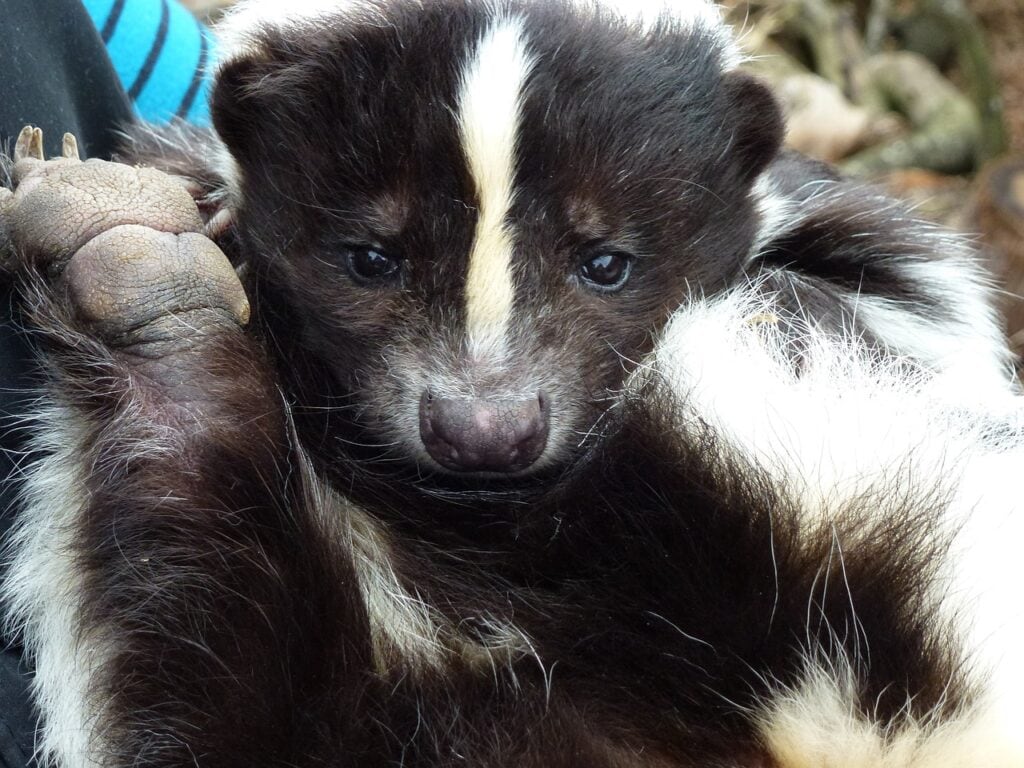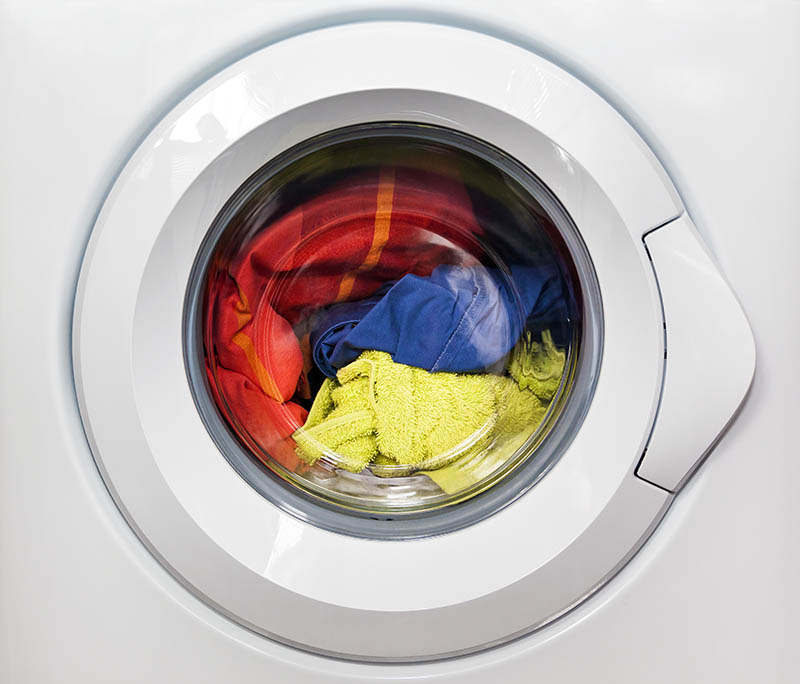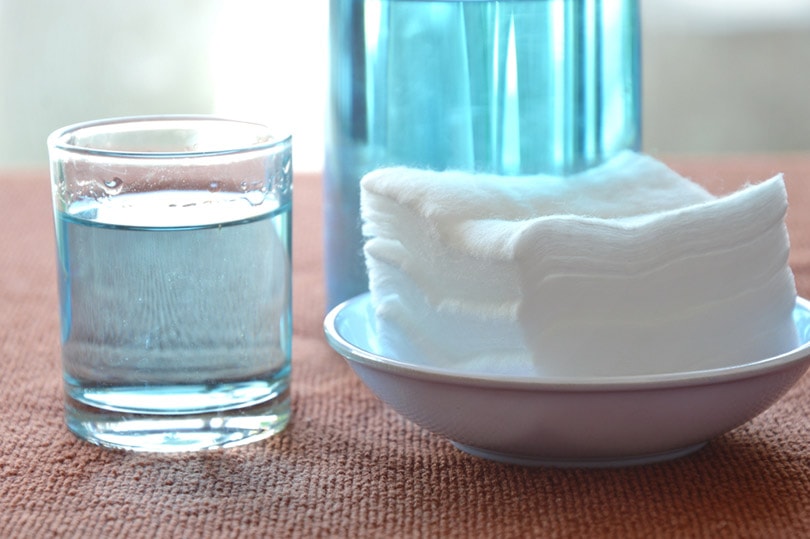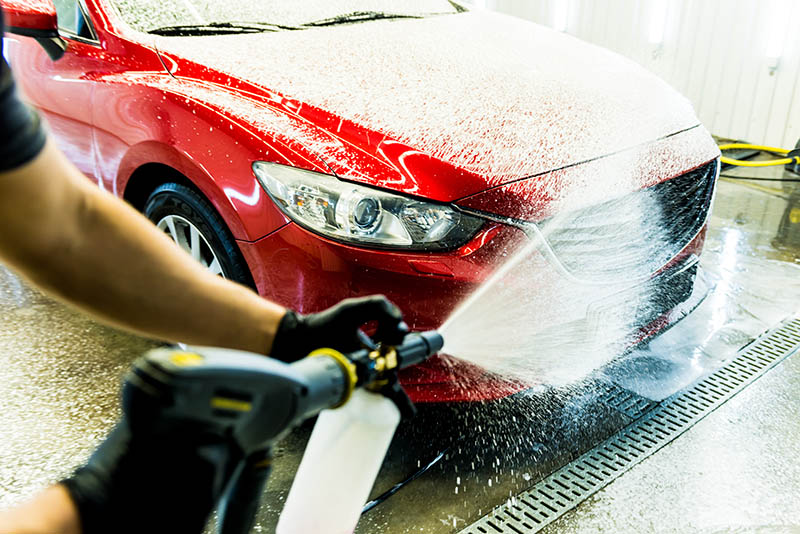How to Get Rid of Skunk Smell From You, Pets, Cars, & Your Home
-
Pete Ortiz
- Last updated:

An unfortunate encounter with a skunk is a painful reminder of how one minor misstep can have severe consequences. Skunk spray is noxious and long-lasting; it’s a pervasive odor that can feel almost impossible to remove despite your best efforts.
You can’t skip work or shut down rooms of your house for days as you try to work out a nausea-inducing stink. Fix the problem fast with these tips to remove the skunk smell from you, your pet, your car, and your home.
How to Remove Skunk Smell From Your Body
Skunk spray, or musk, is an oily substance, so most treatments require a grease-cutting solution. A fragrant deodorant soap or dish liquid will loosen the musk residue and remove the odor when it lands on your body.
- Add 2–4 cups of baking soda to a hot water bath
- Soak your affected body areas for 15–20 minutes
- Shower to rinse off any remaining baking soda solution
No matter your preferred cleaning method, always wash your body as quickly as possible after a confrontation with a skunk. Musk bonds quickly with proteins, including those on your skin, and it can be much more labor-intensive to deodorize if you wait.

How to Get Skunk Spray Smell Out of Clothing
Get rid of the skunk smell on your clothes by running them through the washer. Set your machine to the hottest setting, and wash the affected apparel separately from your other clothes with ½ cup baking soda alongside your standard laundry detergent.
Check your garment tags before treating your clothes. Many natural fabrics like silk or wool can’t handle a wash cycle, and musk may bond more aggressively to the proteins in these materials. Your best bet could be to use a baking soda dusting to deodorize the garment and air it out until you can get it to a dry cleaner.
In many cases, the easiest solution may be to toss the clothing. If you wash a garment multiple times and the odor still won’t come out, the oil is likely soaked too deep into the fabric, leaving you no way to remove it.

How to Get Rid of the Skunk Smell of Your Pets
When your dog has a rough encounter with a skunk, wash the spray out as quickly as possible outside. You don’t want your pet to spread the stink around the house, and removing the odor as fast as possible will be crucial in preventing it from sinking into the skin and fur.
Start by checking your dog’s eyes and demeanor. Skunk sprays can be distressing, especially with a direct hit to the face. You may need to visit the vet if your dog gets sick from the musk going into the mouth or eyes. If it does get in the eyes, you can try flushing them with cool water.
- 1 quart 3% hydrogen peroxide
- ¼ cup baking soda
- 1 teaspoon dish soap
Mix the ingredients thoroughly until it creates a paste. With rubber gloves on, massage the mixture into your dog’s fur immediately, taking extra care to keep the solution out of your dog’s eyes. Rinse thoroughly with plain water, and follow up by washing with regular dog shampoo. You may need to repeat the process several times until the odor disappears.
Don’t let the hydrogen peroxide solution sit on your dog’s body for more than five minutes. Hydrogen peroxide is a mild bleaching agent, so leaving it for a prolonged period can lighten fur. If you and your dog get hit with spray, you can use the same solution to remove a skunk smell from your body.

Tips for Getting Rid of the Skunk Smell in the Car
Skunk smells in the car are rare, but running over roadkill can send a persistent odor across your vehicle. Start deodorizing by opening your car windows to let in the sunlight and fresh air.
Cleaning the Interior
If the smell is intense and sunk into your car’s upholstery, use the hydrogen peroxide and baking soda mixture that works for pets to clean the upholstery. After spot-testing for color fastness, dab a clean cloth into the solution and gently scrub the affected areas.
Since baking soda can be a pain to clean off, taking it out of the equation is more sensible if you want to give your car a more comprehensive cleaning. To clean your car’s interior, mix water and hydrogen peroxide in a 1:5 ratio with baby shampoo. Scrub the carpets and seats, and allow them to air dry with open windows.
Add air fresheners around the car to neutralize remaining skunk odors. Bowls of vinegar work well, as do activated charcoal packs. Should the smell persist after several days, beef up your efforts with a commercial upholstery cleaner.

Cleaning the Exterior
Clean skunk smells from your car’s exterior with vinegar and dish soap. In a sprayer container, blend water and distilled white vinegar in a 1:1 ratio. Add a few drops of dish soap and agitate the mixture. Spray the vehicle with the mixture, ensuring you use a liberal amount on the bottom half, tires, and undercarriage.
Let the solution sit for five minutes before rinsing thoroughly. Hand dry immediately with a clean towel.
Removing the Skunk Smell From the Home
A skunk encounter in the home is unlikely, but if your sprayed dog starts running around inside, it can readily transfer the odor to the carpet and other surfaces. After cleaning yourself and your pet, follow these tips to get rid of a lingering skunk smell in the home:
- Open windows and doors, and turn on fans to air out the house
- Let in as much sunlight as possible
- Swap out A/C filters to prevent skunk smells from circulating
- Place odor absorbers like charcoal bags, plates of baking soda, or bowls of white vinegar around the room
- Steam clean non-launderable materials like drapes and sofa cushions
If there is spray on the carpet or upholstery, spot-treat the area with a 9:1 blend of water and white vinegar. Always spot-test in an out-of-the-way place to ensure the solution won’t leave a stain.
Dampen a sponge with your cleaning solution, and blot the spot to remove the stain and eliminate the odor. Rinse with water afterward to remove any remaining vinegar. You can use the same ratio of water and bleach as an effective skunk odor-remover for hard surfaces.
To remove intense skunk smells quickly, consider a specialty product like Nature’s Miracle Skunk Odor Remover, containing enzymes and oxidizers that break down and remove odorous particles. It’s even safe to use on your pets!
After you begin treating a skunk smell in the house, it should go away in 2–3 weeks. Humid days may intensify the odor. If it hangs around for over a month or gets worse, you may have skunks living around the home. Skunks will live close to humans due to the abundance of food, water, and shelter, so it isn’t uncommon to find a den under a deck or near a shed.

What Is Skunk Spray?
Skunks use a unique defense mechanism whenever they feel frightened. Two anal glands under the tail produce the spray, which the skunk shoots through nipple-like protrusions to fend off a threat. Along with creating a horrid stench, musk can cause nausea, irritate the eyes, and fuel mucus production, having much the same effect as tear gas.
Musk consists of organic substances called thiols, or mercaptan, that create an off-putting odor. Thiols are compounds closely related to alcohols. The primary difference is that sulfur atoms take the place of oxygen atoms in the hydrogen bonds, explaining the awful rotten egg smell.
Humans are extra-sensitive to thiols. We can pick up a skunk smell in concentrations of only ten parts per billion and catch whiffs of spray from over three miles away.
Numerous substances exist in the thiol group, and while they’re generally known to have an unpleasant aroma, some variations are more tolerable than others. Outside of skunk spray, we can also attribute the smell of garlic, onions, coffee, and several other foods to the presence of thiols.
The striped skunk, the most familiar species in North America, utilizes three thiols in its oily yellow spray. Two of these ingredients, trans-2-butene-1-thiol and 3-methyl-1-butanethiol, are responsible for most of the smell.
Three more compounds, called thioacetates, also exist in the spray, and while they don’t produce as much stench, they convert to thiols and create a stink when they mix with water. Thiols cause most of the smell, but thioacetates allow it to linger. If you bathe your dog after a skunk encounter, thioacetates are why the odor seems to get worse when its fur is wet.
When Do Skunks Spray?
Fortunately, skunks don’t spray first and ask questions later. In most instances, they’ll do everything they can to preserve their stores of musk, keeping it handy only for the direst situations.
A skunk can spray up to six times before depleting its sacs. It may take 10–14 days before it can use them again. Rather than risk waiting two weeks for its primary defense to reload, a skunk will either flee or give an initial warning before spraying. The striped skunk will stomp its feet, hiss, and arch its tail to let you know it’s ready to engage. You can often avoid their stinky spray by taking the hint and backing off slowly.

How Far Can Skunks Spray?
Skunks can begin spraying as early as 4 months old, though they don’t optimize their range and aim until adulthood. An adult skunk can shoot its spray 10–15 feet with remarkable accuracy. If you escape a skunk encounter with spray only on your clothes, you can count yourself lucky. A skunk can articulate its anal secretors to set up its target and will typically shoot for the eyes so it can escape.
How Long Does Skunk Smell Linger?
Without intervention other than airing the affected room or piece of clothing out, it can take about 14–21 days for a skunk smell to dissipate. Untreated or extra-powerful sprays can last for months. In general, waiting to handle skunk spray will only make it last longer and become more challenging to remove.
Conclusion
Happening across a skunk near the home can be a little nerve-wracking, but in most cases, it’s up to you whether you get hit with a faceful of spray. Skunks don’t want trouble and do everything they can to dissuade potential threats through their familiar stripes and initial warning signals. Avoid walking the dog at dusk or dawn to dodge skunks at their most active hours, and follow these tips to quickly and effectively get rid of a skunk smell when misfortune strikes.
Featured Image Credit: Pixabay
Contents



